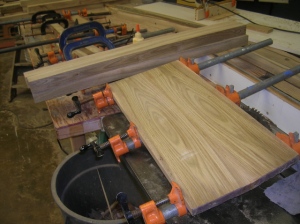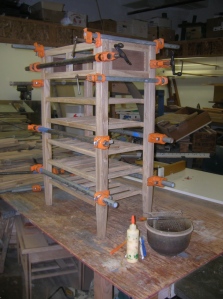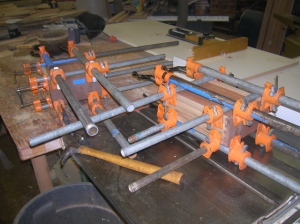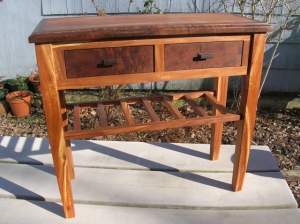A Wine Console Table out of White Oak & Black Walnut
January 13, 2010
There was one of those wind storms that made the news a few years ago. My wife’s client came in and told her a big tree had fallen on her neighbor’s house. She called me. It was close by. I arrived to find utility crews trying to restore power to the neighborhood. A huge White Oak had fallen, taking out power lines and the corner of a house.
The trunk was six feet in diameter and maybe fifty feet tall. I tried to talk the property owner into letting me get a sawyer with a mobile band mill to cut it up and I would clean up the property. I tried to offer him five thousand dollars at first, but he thought I was pulling his leg. I ask if he had talked to his insurance company yet, knowing that home owners insurance doesn’t cover acts of God. Maybe I was crazy but there was a lot of material in the tree.
He somehow thought I didn’t know what I was talking about and said he didn’t want the liability. I told him I had a CCB license, two million dollars in liability insurance and could draw up a contract for $7,500. He said no. I ask if I could cut a couple of logs as the utility crews were already making a huge mess clearing branches. He said no and left in his car. I went home, got my chain saw, came back and cut some branches left in the street. They were eight to ten inches in diameter and at 40″ long I could barely lift them into the pick up.
I heard later that he paid to have the tree cut up into fire wood and hauled off. Such a waste. I suspect he had to pay for extensive repairs to the neighbors house too. I dried these logs in my shop for two years and here is what I call my SW Crestwood Lane wine table:
Once I get a flat spot I can square it up on the jointer.
Wow! Nice. Pretty clear. I can make a top out of that.
Let’s see what’s in the second log.
I don’t have a big shop or big tools. I’m resigned to work with what I have.
Some day if I can sell this stuff, maybe I can buy a big band saw.
This was my Dad’s saw and it’s really sharp. I rip away.
I get the pieces under 6″ so I can get it in my trusty 14″ Rockwell band saw.
I stack the material on stickers and let it acclimate for a couple days.
Here I glue some Black Walnut for the feature strip in the top.
I book match two nice clear pieces for the field in the top.
I use a tongue and groove cutter to join the edge band to the field.
Then I start on frames that will house the inset panels in the carcase.
The top.
The panels glued up.
I rip material for the wine racks.
I plane parts to thickness.
To make tenons, I cut shoulders on the table saw and remove the rest with the router table.
I have a jig that hold the pieces at 45 degrees to five me an octagonal tenon.
Some day I will build a machine to make round tenons but for now it takes a few steps. I can do it pretty fast now. I can make the joints tight and the octagonal shape allows glue to squeeze out easily in assembly.
Maybe some day I can afford a hollow chisel mortice machine, but using the drill press for a round mortice and tenon joint is fast and accurately.
Racks glued up.
I rip some pieces out of the center of the log for legs.
I cut tapers on the bottom of the legs with an old jig.
I mortice the tops of the legs for the carcase panels.
On the router table, I use an Incremental Positioning Machine, which is a fence that is adjustable in detents of a thousandth of an inch. Very accurate.
Assembly and glue up.
I cut material for drawer parts.
The IPM machine has templates to make box and dovetails joints fast and easily. I’m not really a purist and it takes some skill to make this work too. Hand cut dove tail joints are great but only one person in a thousand knows the difference. Only one in ten thousand would even care.
Over years I have developed my signature drawer pulls. It takes five router set-ups to make them, so I make a few dozen at a time out of various woods so I have a supply and don’t have to stop and spend the time to make just a couple.
When you grab them to open the drawer they feel really nice in your fingers. I mortice and glue them into the drawer fronts.
I apply an oil formula that I custom mix. Then I use Watco finishing wax and Minwax paste wax for the finish.
Thanks for viewing!
Number one… KTW#0104
January 9, 2010
In the winter of 1977 a nasty storm ripped a big limb from an old Black Walnut tree in my back yard in San Mateo, California. I chained sawed it into three foot long logs and sliced them length wise with a razor sharp Fanno pruning saw. My hands were left covered in blisters. I moved these pieces of Walnut around for years not sure what to do with them.
About 1994 I was doing a remodel in Palo Alto. One morning I came to the job to find a tree service cutting down a gigantic tree in the front yard. I ask what it was and the contractor said it was the biggest Apple tree he had ever seen. They cut it into fire wood, but I grabbed a couple 10″ thick branches about three feet long.
On one trip, when moving my shop to Portland, I towed a trailer with a stash of wood I had been air drying for many years. My wife looked at it and and said, “I know you are wood collector but you moved firewood?”
Most all the furniture in our house, I have built over time out of left overs from jobs or scavenged out of debris boxes. I can’t really afford to keep my own work anymore, but sometimes, I have so much time and energy into a piece that money can’t compensate me. This is my “Rotten Apple” table. It was the first project I built in my new shop out of the Spalted Apple logs and what was left of my Black Walnut stash. When I was done, there were barely enough scrap to kindling a fire. It is only 29″ tall because that is how long the log was.
It is finished with a traditional oil and wax. Over time, like most fruit woods, the color has become rich and dark. This piece was the inspiration for my first series of Wine Console Tables.
I love slicing up logs to reveal the treasures inside. I get pleasure in watching router or shaper bits peel away the grain. I could do this for the rest of my life and never get bored.
Clary Philipp-Knot Traditional Woodworks-Portland
January 8, 2010

Welcome to D'olSkankeyWorkChop
Located in the basement of an old furniture factory in the industrial district of South East Portland, I built my shop space out from scratch in 2005. I’m about five blocks from the Willamette River near the end of the Hawthorne Bridge, just minutes from downtown.
My first shop was in an open carport with a dirt floor, a hundred watt light bulb and a Sears Craftsman table saw that I bought for $187 back in 1977. I lived in San Mateo California and started working as laborer for a remodeling contractor, digging ditches for $3.25 an hour. In a few months I became a carpenter apprentice and in the following years I worked in all kinds of construction jobs and eventually got my California contractors license. The next twenty years saw me build and work out of five big and small woodworking shops. I moved to Portland, Oregon in 2002 and started Knot Traditional Woodworks as a remodeling business specializing in finish carpentry and cabinet installation. I built the shop to facilitate my remodeling endeavors.
The economy in Oregon was still working and at 50 years old so was I. In 2004, I got hit by a 16 year old red light runner. That was a wake up call for me that my body was starting to give out on me after 25 years of construction work. It took me almost a year to recover.
One morning I was reading the Oregonian and drinking coffee. I had been thinking about ways to restart my contracting business or maybe some other way to make a living. I couldn’t see my self doing carpentry in the rain and cold into my sixties and seventies. I had a vision that maybe I should come up with an idea for a product that I could use my passion and skill in woodworking to start an new business model. An article on the front page of the paper was about the growing wine industry and how it was the third largest business in the state at 54 million dollars. A little light bulb went off in my head and I thought I should be able to carve out a little of that some way. Then It hit me. I can design and build wine racks and maybe try to use recycled and reclaimed materials.
I did a lot of research on existing wine rack companies and then started to build prototypes of my own designs. It took me a long time to solve the different problems I encountered and I’m still tweaking my tools, jigs, production process, design ideas. This last year I quit contracting and have been a craft vendor at farmer’s markets, wine festivals, wine tastings and the world famous Portland Saturday Market.
Now that I have been at this for a few years, I have started to build an inventory of hardwood logs that I cut from the urban forest. Local exotic hardwood trees are being taken out for development and fall as a result of storms. Money does grow on trees.
I hope this blog will chronicle the evolution of my woodworking business and my experiment in direct marketing. It’s a tough time to be in business or to be starting a new business. The economy here is just destroyed… thanks dubya. But hey, it’s a new year, new decade and seriously it won’t take much to be better than 2009. Here we go…

Old growth Fir window sash and jambs I fished out of a dumpster

Three case model in fir, marble top with California Redwood panels

























































